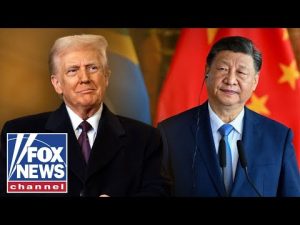**ICE Takes Action on Illegal Vendors After Influencer’s Viral Report**
In an unexpected twist worthy of a reality television plot, the streets of New York City have become the backdrop for headlines and heated discussions following a complaint that led to an ICE raid. The focus? Canal Street, a bustling area known for its street vendors and a particular market of goods that recently grabbed the attention of a well-known MAGA influencer, Savannah Hernandez. Riding the wave of social media, Hernandez’s observations ignited a series of events that would leave many scratching their heads in disbelief.
As Hernandez drove through New York City, her Uber ride turned into much more than a simple commute. She stumbled upon a large gathering of vendors — mostly consisting of African migrants selling counterfeit designer bags, such as Louis Vuitton and Yves Saint Laurent. It was a scene straight out of an urban mockumentary: throngs of people haggling over fake handbags while vendors hurriedly packed up their illicit wares upon sensing the slightest hint of trouble. Before Hernandez had even finished recording, the vendors disappeared, leaving behind nothing but the memory of their bustling marketplace.
A mere few days after Hernandez’s video went viral, capturing a staggering reach of about five million impressions, ICE swooped in on Canal Street. They arrested nine illegal immigrants, some of whom possessed criminal backgrounds, in operations that seemed curiously timed with Hernandez’s online exposé. For some, the connection sparked wild conspiracy theories about social media influencers having the power to mobilize federal agencies. However, the situation reveals a growing tension between media narratives and the realities on street corners in America.
Opinions vary wildly on whether the crackdown was warranted or an excessive response to online commentary. On one side, some argue that arresting individuals engaged in illegal activities is common sense; after all, laws for a reason exist. Others, however, howled in protest claiming it showcased a disregard for immigrant rights. Vocal leftists labeled Hernandez a “poverty tourist,” insinuating that her presence and reporting turned a spotlight on vulnerable communities solely for clicks and views. Nevertheless, Hernandez shrugged off the criticism, humorously stating that she wasn’t on a treasure hunt for stories but merely observing life as it plays out in her city.
Yet, Hernandez’s foray into the streets wasn’t without its share of tense moments. During her time filming, she encountered agitated vendors who were less than keen on being documented. An unsettling exchange followed when one migrant reacted defensively, providing a stark reminder that tensions can run high in such precarious situations. She described a scene where people on the streets shouted for her to stop filming, demonstrating just how thoroughly intertwined the issues surrounding immigration, crime, and public perception have become.
In the aftermath, ICE’s raid has sparked debates that go beyond the confines of Canal Street. Whether Hernandez’s actions amount to responsible journalism or unwarranted provocation, it raises a fundamental question: should misinformation or illegal activities be tolerated in the name of preserving urban culture? With the media now shining its light on Canal Street, what had once been an overlooked corner of the city will likely face ongoing scrutiny in the name of law and order. Meanwhile, Hernandez remains a polarizing figure at the heart of the conversation, one who wields her influence with unapologetic flair and a knack for stirring the pot. As the situation unfolds, one can only imagine what other surprises lie ahead for the streets of New York City.







